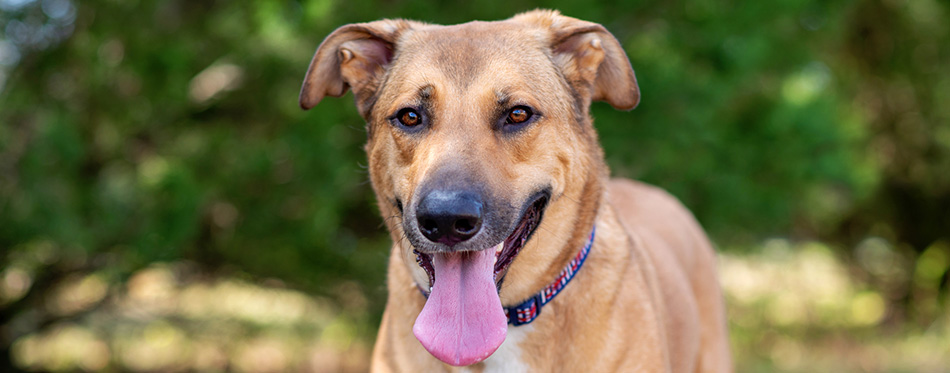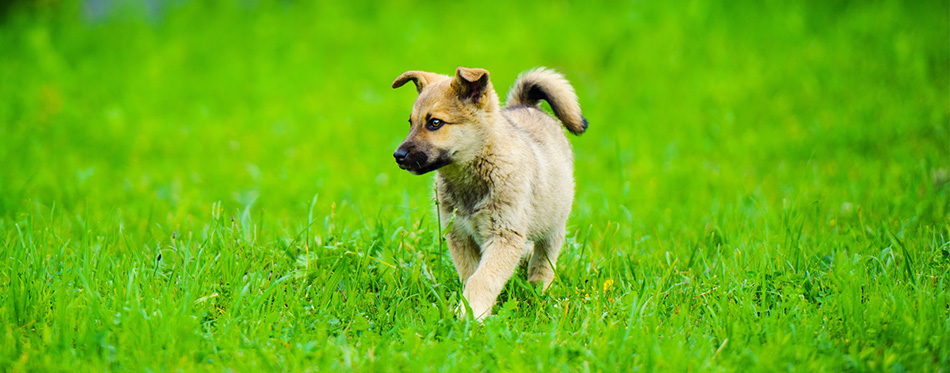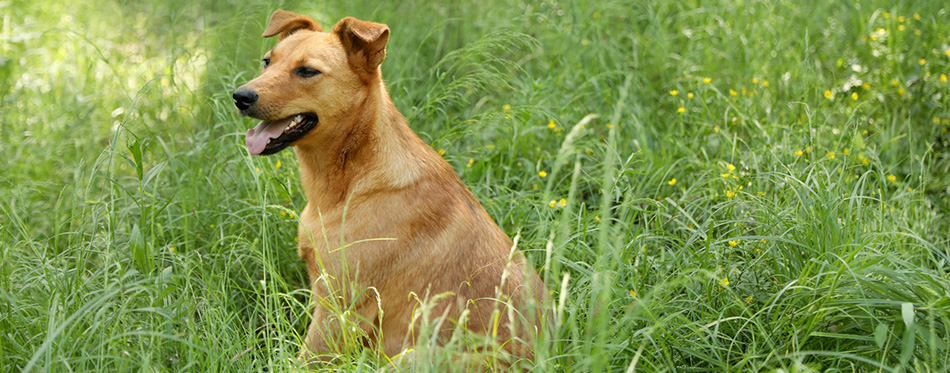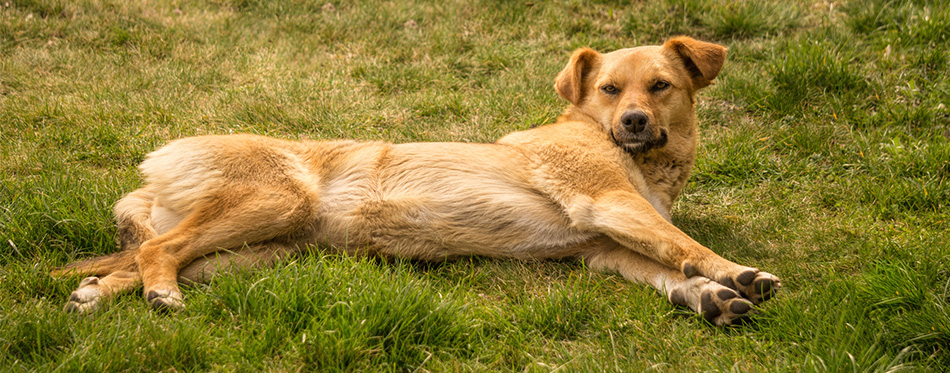If you want the right dog for your lifestyle and family, choosing the right breed is crucial. Every dog has a different temperament, and some would say a different purpose too, and it is vital to know this before committing to a particular breed. Chinook dogs are one of the rarer breeds and ones with a very interesting history. Case in point: despite its native American name, the breed was developed in the White Mountains of New Hampshire, and is today this state’s official dog. In terms of appearance, the Chinook sled dog stands at 21 to 27 inches tall with a balanced and muscular body. This is a large canine with a rectangular head and variable ear types, typically with brown to amber eyes and a medium-length double coat. In this article, we give you detailed information on the Chinook dog, in the hopes of helping you decide if this is the right breed for you and your family.

History of the Chinook Dog
The Chinook breed exists mainly because of Arthur Treadwell Walden, a man from Wonalancet, New Hampshire. The breed has one male ancestor named Chinook, born in 1971, who came about as a readily of cross-breeding between a female Greenland dog and a large male Mastiff/St. Bernard mix. Existing pictures of the breed show a dog with drop ears and a broad Mastiff head and muzzle. Chinook who was Walden’s lead stud, was bred to Canadian Eskimo dogs, Belgian sheepdogs and German shepherd dogs. The immediate descendants were sent back to him for the desired standard to be set. Walden had a lot of experience as a dog driver in Yukon and he was the head trainer and driver in an Antarctic adventure. He is also known as the one who brought sled dog sports to New England and founded the New England sled Dog Club in 1924.
Chinook, when he was 12, got lost during the Antarctic expedition. Core breeding stock was handed over to Julia Lombard from Walden and then in the late 1940s to Perry Greene. Greene was a noted outdoorsman who bred the breed in Maine until his demise in 1963. Because he was the only breeder during that time, the population of Chinooks started to reduce and only 11 breedable dogs were left by 1981. They were shared among breeders in Ohio, Maine and California to prevent them from becoming extinct. I’m 1991, the breed gained registered status by the UKC and currently, there are 800 registered dogs. Despite this figure, only 100 dogs of this breed are born every year. The breed joined the American Kennel Club in 2001 and in 2010, was included in the Miscellaneous Class. In January 2013, the Chinook became part of the working group of dogs were the 176th breed in the Club.
Quick Facts About The Chinook Dog
- They enjoy pulling things: This breed has a history of being sled dogs since they have lived and worked in colder climates. They are large dogs capable of pulling their own weight plus added cargo. According to the AKC, the breed loves to pull things, and based on their history of winning sled dog competitions, this is more than believable. Their large size coupled with their outdoorsy nature makes them the perfect breed for sled pulling.
- There is a variety of ear types within the breed: Many breeds are identified by some physical features, including the shape of the ears, but with this breed, things are a little different. Every individual dog can have a different ear shape whether floppy or pointed. If you want a Chinook dog but with a specific type of ears, then you are likely to find one without looking too hard.
- There is a debate surrounding neutering them: A lot of talks are going on when it comes to neutering or removing the sexual organs of this breed. Neutering is done to control the population, however, at some point, too many of Chnook dogs were neutered and so they almost became extinct. Now, many experts advise against neutering Chinooks, but of course, this is ultimately up to the owner. Since the debate began though, the number of these beautiful dogs has started to rise, and the breed is returning to its former glory.
- Their name is adopted: The first dog from which this breed descended went by the name Chinook. It was, of course, a non-Chinook dog that led a team of sled dogs Walden had in Canadian Yukon, but since this was the first team to introduce dog sledding as a sport, and also the team that won the competition, Walden decided to name the descendants of that dog after Chinook. interestingly, the name has never been modified or changed since then.
- They are fantastic family dogs: while the large size of this breed may make it a little challenging to feed, its lovable and friendly personality makes it an ideal family dog. Chinook is comfortable around loving and welcoming people and doesn’t mind being inside the house even though it is naturally an outdoor dog.

Things You Should Know
Health
The chinook has a lifespan of 12 to 15 years, and within that period, they are prone to certain health issues. Hip dysplasia and epilepsy are some of the major issues this breed may face in their lives. Hip dysplasia occurs when there is an abnormality in the formation of the hip and can lead to severe, crippling pain in the animal.
Epilepsy refers to chronic seizures, and according to the Chinook club health survey, about 8% of the breed is affected by one form of seizures or another. They might also experience other orthopedic illnesses including elbow dysplasia and the luxating patella which is the official name for loose kneecaps.
These health issues can be reversed mainly through surgery but have the potential of developing into arthritis later in the dog’s life. Eye diseases such as cataracts, retinal dysplasia, and persistent pupillary membranes are not uncommon with this breed. They might also develop itchy skin due to allergies which can progress into skin infections like hot spots. Apart from these, chinooks can also suffer from heart disease, bone cancer, chronic diarrhea, and hypothyroidism. Prevention of illnesses will include regular visits to the vet and engaging in healthy practices at home. In the case of genetic or hereditary diseases like epilepsy and hip dysplasia, there is little you can do except make them comfortable.
Training
Training a Chinook dog is considered to be fairly easy because they are smart and adaptable. One of the first things to teach them is to avoid jumping onto visitors when they first meet them. They can be trained without a leash on and one of the first things you must try to curb is jumping. It is helpful to train them with positive reinforcement methods so that they learn to repeat good behaviors. Consistency works like a charm, and the Chinook is guaranteed to learn faster that way.
Training should start with the Chinook puppy since good behavior is more likely to imprint when they are young. Socialization is also important if you want them to behave well when there is company. You can house or crate-train them as you like, and if you are having any difficulty, you can consult a professional trainer to help. Be gentle but firm with this dog and try to establish who the boss is early on so they know to treat you with respect.
Exercise
Chinooks are all-purpose dogs and so can do anything and everything. It is for this reason that they need to be busy often so that they do not get bored. They need exercise to keep them stimulated and to maintain their health. Daily walks of 30 minutes to an hour around the neighborhood will do them good. You can also take them out to jog or play around, provided it is in moderate amounts at a time. They enjoy exercise, so if you are looking for a dog to spend your outdoor time with then the Chinook breed is ideal for you.
They also love cuddle time and so you should make time to have a nice time indoors to spend quality time together. Even though they can be kept off the leash, it is better to keep them in an enclosed space where the environment is controlled. This is because they can be strong-willed, especially if not trained early on.

Nutrition
Chinooks are large dogs and need proper nutrition to support their metabolism. Quantity is as important as the quality, and you must pay attention to what goes into the Chinook’s diet so that you do not harm their health. The recommended amount of food to feed this breed is 3 1/8 to 4 5/8 cups a day, divided into two meals. Of course, this portion will differ with age, activity level, metabolism, dietary requirement and build, among other things. Regardless of these factors, whatever you feed the Chinook must be high-quality.
The best way to keep this breed in shape is to give them meals at specific times of the day rather than keep food in their bowl at all times. Having an obese dog can affect their quality of life by bringing many health issues. You can feed them high-quality dry food or kibble, as well as a raw diet consisting of meat and vegetables. You can include snacks in their diet provided it will not trigger any allergies. A veterinarian will be the best person to come up with a diet plan for the animal and a perfect one at that. Wet food is not recommended in large quantities for this breed because it can cause dental issues, including gum disease. However, in small amounts or mixed with kibble, it can be great.
For more guides on choosing the right dog food, you may wish to check out our reviews of the best dry dog food, organic dog food, grain free dog food, wet dog food and puppy food.
Grooming
Chinooks have double coats with medium-length hair, but those living in warm temperatures have less dense coats than those in colder climates. They have tawny coats with color ranging from light honey to reddish gold, with black markings on parts of their bodies like the inner corners of their eyes, ears, and muzzle. They are moderate in shedding, so brushing their coat daily can keep that under control. Bathing can be once or twice a year or when they become visibly dirty. Nail-trimming can also be done weekly while brushing their teeth can happen twice to three times every week. Aside from these grooming activities being healthy, they also provide you with an opportunity to bond with the dog. Pay attention to their bodies, looking out for sores, redness or any other anomaly that may be signs of an infection. Do bear in mind that grooming should start when the Chinook is a puppy so that they get used to it quickly.
For more help on dog grooming, you may wish to read our guides on the best dog nail grinders, dog dryers, dog clippers, dog paw washers and dog shampoo.
Temperament
Chinooks are generally sweet dogs, but as unbelievable as it sounds, some people try to train them to be meaner. This is because they are large and so people assume that they should be frightening. On the contrary, this breed is very cheerful, calm, eager to please, and friendly. They are also gentle and loving and do not have a bone of shyness or aggression in their body. They are not known as barkers and crave constant companionship, so leaving them alone for too long can make them feel sad and lonely. They make great family dogs because they are patient and adapt quickly to new environments. They also do well in teams as they don’t try to dominate others. They can sometimes be reserved, especially if they do not know you, but early socialization is the solution to this problem.

To Summarize
If you are thinking about getting a Chinook, we hope the information above is of use to you. In a nutshell, this breed is for you if you like large dogs and have plenty of time to spend with your pet. Despite its large size, this breed is not for you if you are looking for a guard dog for your home or space. They make great family pets and easily adapt to new environments, so they can be comfortable both in houses with yards and in apartments. They are big though, so you must consider the cost of feeding them to enable them to live healthy lives. Getting a pet can enrich your life in so many ways, however, you must also think about how the animal can live comfortably so that you have a mutually beneficial relationship.
Source:
- A Brief History of the Chinook – Chinook Club of America

